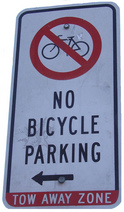When condo bylaws prohibit bike parking

Photo by Jeffrey Beall on Flickr.
The bylaws of older condominium associations often hinder the ability for communities to evolve as the needs of residents change. Some condo associations grapple with this issue as more residents start to ride bicycles.
Matt Johnson rents a condo in Greenbelt. His condo association’s rules prohibit storing bikes on balconies. But there’s nowhere else to store them outside; there are no bike racks outside anywhere.
They do have a “bike room” in the basement. It is completely unmarked; Matt just assumed it was an electrical closet for the first 3 years he lived there. After the building captain mentioned it to Matt, he went and looked inside.
There are no bike racks or any other elements to which it is possible to lock a bike. It’s a big square room with cinderblock walls. Most of the room is full of junk from other residents, just stacked in there, no organization whatsoever. It looks like the only thing not stored in that room are bikes.
Instead, Matt keeps his bike in the dining nook during the warmer months. Whenever he and Ryan have guests over or during the winter, he moves it to their storage locker (also in the basement). It barely fits inside.
Even if they had a bike room, Matt probably wouldn’t use it, because having to carry it up and down a bunch of stairs and going through 2 locked doors (for which each unit gets only 1 key) would inhibit daily use of his bike.
Veronica finds high hurdles to change her condo bylaws
When Veronica was president of her condo board in Fairfax Village, in DC’s Ward 7, she looked into adding bike racks in their parking lot. However, the association’s bylaws, written in 1974, prevent storing bikes outside:
Co-owner shall not place or cause to be placed in the public hallways, walkway, driveways, parking areas or other Common Elements any bicycles, furniture, packages or objects of any kind. The public hallways, walkways and driveways shall be used for no purpose other than for normal transit through them.
Once that was a no-go, she looked at the possibility of converting a basement space into a bike room. However, the same provision includes “other Common Elements.” Another section of the bylaws has a half page definition of “Common Elements,” which includes basements.
Amending the association’s bylaws would require approval by two-thirds of owners at a meeting called specifically for that purpose. That’s not an insurmountable task, but it would take a significant effort to get that percentage of owners at a meeting.
Given all of their other projects such as the community garden, bike parking fell to the bottom of the list. Fortunately, unlike with Matt’s condo, most (if not all) of the residents that have bikes either own a garage unit or store them in a neighbor’s garage unit.
DC’s proposed new bike parking regulations might trump the bylaws, at least for some condos in the District. It’s unclear if they would affect Veronica’s condo, since the regulations only apply to buildings of 8 units or more, and Veronica’s is 3 separate structures of 6 units, all connected together with plumbing. We emailed DDOT yesterday to find out, but hadn’t heard a definitive answer by posting time.
